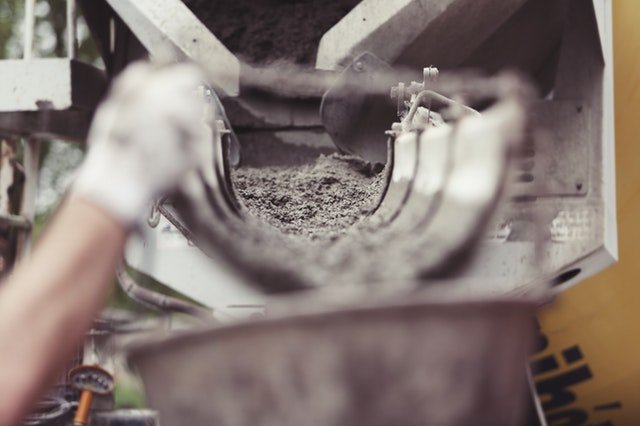Concrete
Definition
Concrete is a Building Material Made by mixing Cement, Sand(Fine Aggregate), Gravel(Coarse Aggregate) with water and allowing it to get Harden.
If worked properly and let it hardened then Concrete is durable, Watertight and has high compression strength. Its fluid-like state is very workable and has a vast variety of possible forms. Quality control of concrete is essential prior to and post-placement of concrete.

Click here for Construction Classifieds
Application of Concrete
Concrete has a huge application range. some examples are Column, Beam, Slab, Footing, Domes, Vaults, Thin Shell structures, etc. As mention earlier, Concrete can be formed in a vast variety. sometimes it can be used in decorative items also. It has high compressive strength so it ultimately has huge applications.

Material advantage of Concrete
Concrete is a very versatile material and it has huge material advantage some of the examples are as given below,
- Can be used almost anywhere since the ingredients are readily available.
- Requires a minimum of highly skilled labor to mix and place which means it is
a relatively economical material. - As a material, concrete is as strong as natural stone. It is durable and
resistant to the elements. - It is an extremely flexible building material, capable of taking on virtually any
shape.

Recipe of Concrete-
- Ingredients:
– Cement
– Fine Aggregate
– Coarse Aggregate
– Water - Directions:
– Add ingredients together.
– Place in container of desired shape and form.
– Allow mixture to set.
– Remove container.
– Decorate as desired.
– Allow mixture 28 days to reach full strength
Ingredients
As mentioned above, Here are some more details about concrete ingredients.
- Portland Cement :
– Manufactured from lime, silica, iron oxide and alumina.
– In its dry state, Portland Cement is a very fine powder. When mixed with water, a paste is formed. As the paste begins to set, the cement loses its plasticity.
– The initial set occurs within an hour and the final set takes about ten hours. The cement, however, continues to harden and reaches its full strength after 28 days. Portland cement is the paste used to bind the fine aggregate with the coarse aggregate. - Fine Aggregate :
– Consists of sand or another suitable fine material.
– Fills the spaces between the coarse aggregate.
– Fine particles are necessary to allow for good workability and
smooth surfaces when hardened.
– An excess of “fines” requires an increase in the amount of
cement, increasing cost and overall shrinkage of the mix. - Coarse Aggregate :
– Consists of crushed stone or gravel larger than fine aggregate,
but small enough to fit comfortably between reinforcement bars.
– It should be hard and durable as opposed to soft and flaky.
– Because more cement is required for smaller aggregate, the size of the coarse aggregate has an impact on the cost of the concrete, but the larger aggregate is more difficult to work with and
may be more expensive to handle. The choice of gravel or a crushed stone has an impact on strength and workability.
– The maximum aggregate size should be less than 1/3 the thickness of concrete slabs or ¾ of the minimum space between reinforcing bars. - Water :
– It should be clean, free of oil, alkali, and acid. In general, it
should be drinkable. - Additional Optional Ingredients
– Lightweight Aggregates – used to produce Structural Lightweight Concrete which can weigh 60% less than normal aggregate concrete. Other lightweight aggregates are used to produce Insulating Concretes.
– Special Portland Cements – made to meet different physical and chemical requirements for specific purposes. Some of these include white portland cement, high early strength cement,
sulfate resisting cement, air-entraining cement, low heat cement, etc.
– Admixtures –chemicals added to the concrete mix to alter the normal properties of the mix in a variety of ways. These include (but are not limited to) the following:
– Retarders – delays the time it takes for the concrete mix to stiffen and meet full strength.
– Accelerators – increases the speed with which the concrete sets and meets full strength.
– Water Reducing Admixtures – permits lower water content and improves workability.
– Waterproofing agents – decreases concrete permeability.
– Workability agents – improves the workability of the mix.
– Air Entraining Agents
– Air entrained concrete can be achieved using either an admixture or air-entraining
portland cement. Air entrained admixtures produce many microscopic stable air bubbles in concrete.
These bubbles will improve the workability and durability of concrete and produce a hardened concrete
that is resistant to severe frost action. Because of the presence of bubbles, air-entrained concrete requires
less water than non-air entrained concrete. However, it must be noted that this type of concrete is
somewhat weaker in compression. It should, therefore, be used only where freeze-thaw cycles occur.
Placing Of Concrete
In hardening, transporting and placing concrete, it is essential to avoid separation of aggregate from the cement, and of water from the other ingredients. The following precautions should always be taken when placing concrete:
– Forms should be tightly constructed, clean, treated with a release agent, and moistened.
– Reinforcement should be clean, free of dirt and rust and placed in the proper location.
– Concrete must not be allowed to dry out too rapidly (which can happen in excessive heat) or to freeze.
– Concrete should never be placed on a frozen subgrade or where there is standing water.
– Concrete should not be placed in very large quantities but in layers of uniform thickness.
– Concrete should NEVER be dropped from great heights as this will cause separation. Vertical drops should be limited to four feet.
– When new concrete is placed on hardened concrete, the surface of the hardened concrete should be moistened and prepared using sandblasting water jets, or other means to provide a watertight joint.
– Concrete should be deposited as close as possible to its final location, as moving it will segregate the mix.
– Concrete should be compacted or consolidated by hand after placement to eliminate trapped air bubbles. This can be done with mechanical vibrators either outside the formwork or immersed in the concrete. Excessive vibration, however, will also segregate the mix

